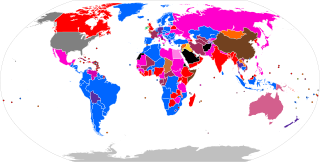
Approval voting is a single-winner electoral system where each voter may select ("approve") any number of candidates. The winner is the most-approved candidate.
Score voting or range voting is an electoral system for single-seat elections, in which voters give each candidate a score, the scores are added, and the candidate with the highest total is elected. It has been described by various other names including evaluative voting, utilitarian voting, the point system, ratings summation, 0-99 voting, average voting, and utilityvoting. It is a type of cardinal voting electoral system.

The two-round system is a voting method used to elect a single winner, where the voter casts a single vote for their chosen candidate. However, if no candidate receives the required number of votes, then those candidates having less than a certain proportion of the votes, or all but the two candidates receiving the most votes, are eliminated, and a second round of voting is held.
Bucklin voting is a class of voting methods that can be used for single-member and multi-member districts. It is named after its original promoter, the Georgist politician James W. Bucklin of Grand Junction, Colorado, and is also known as the Grand Junction system. As in Majority Judgment, the Bucklin winner will be one of the candidates with the highest median ranking or rating.
The Condorcet candidate is the person who would win a two-candidate election against each of the other candidates in a plurality vote. For a set of candidates, the Condorcet winner is always the same regardless of the voting system in question. A voting system satisfies the Condorcet criterion if it always chooses the Condorcet winner when one exists. Any voting method conforming to the Condorcet criterion is known as a Condorcet method.
The participation criterion is a voting system criterion. Voting systems that fail the participation criterion are said to exhibit the no show paradox and allow a particularly unusual strategy of tactical voting: abstaining from an election can help a voter's preferred choice win. The criterion has been defined as follows:
Resolvability criterion can refer to any voting system criterion that ensures a low possibility of tie votes.
Instant-runoff voting (IRV) is a voting method used in single-seat elections with more than two candidates. Instead of voting only for a single candidate, voters in IRV elections can rank the candidates in order of preference. Ballots are initially counted for each elector's top choice, losing candidates are eliminated, and ballots for losing candidates are redistributed until one candidate is the top remaining choice of a majority of the voters. When the field is reduced to two, it has become an "instant runoff" that allows a comparison of the top two candidates head-to-head.
A single-member district or single-member constituency is an electoral district that returns one officeholder to a body with multiple members such as a legislature. This is also sometimes called single-winner voting or winner takes all. The alternative are multi-member districts, or the election of a body by the whole electorate voting as one constituency.
Instant-runoff voting (IRV) is used for state and congressional elections in Maine and for local elections in 11 cities, where it is often called "ranked-choice voting." Those cities include San Francisco, California; Oakland, California; Berkeley, California; San Leandro, California; Takoma Park, Maryland; Basalt, Colorado; Telluride, Colorado; St. Paul, Minnesota; Minneapolis, Minnesota; Santa Fe, New Mexico, and Portland, Maine. It is pending implementation in several additional cities, including in 2019 in Las Cruces, New Mexico and St. Louis Park, Minnesota. IRV is commonly used for student government and other non-governmental elections.
The Borda count is a family of single-winner election methods in which voters rank options or candidates in order of preference. The Borda count determines the outcome of a debate or the winner of an election by giving each candidate, for each ballot, a number of points corresponding to the number of candidates ranked lower. Once all votes have been counted the option or candidate with the most points is the winner. The Borda count is intended to elect broadly-acceptable options or candidates, rather than those preferred by a majority, and so is often described as a consensus-based voting system rather than a majoritarian one.

An electoral system is a set of rules that determine how elections and referendums are conducted and how their results are determined. Political electoral systems are organized by governments, while non-political elections may take place in business, non-profit organisations and informal organisations.

STAR voting is an electoral system for single-seat elections. The name stands for "Score then Automatic Runoff", referring to the fact that this system is a combination of score voting, to pick two frontrunners with the highest total scores, followed by a "virtual runoff" in which the frontrunner who is preferred on more ballots wins. It is a type of cardinal voting electoral system.
Tideman's Alternative Methods, including Alternative Smith and Alternative Schwartz, are two electoral systems developed by Nicolaus Tideman which select a single winner using votes that express preferences. These methods can also create a sorted list of winners.










